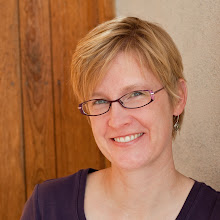After the usual
But the favorite exercises are usually the ones where we move color vertically.
This is really rewarding to do and after experimenting with moving one hue from light to dark, some people got crazy with grading between hues while changing values. (I expect great things out of this lot, I have to tell you.)
A big thanks to Kevynne Layne for getting this particular class off the ground with a group of weavers from the Damascus Fiber Arts School in Oregon. Marcia and Heather joined the group from Colorado and California and we had a wonderful group of 6 plus me.
As a teacher, you're always on alert at the beginning of a class to try to figure out which students are going to understand the way you best like to teach and which ones are going to need you to re-arrange your brain to explain things in their thinking style. And then there are the students like Janet who pick everything up right away and run with it.
That progressive hachure exercise she did in peach and orange is always the hardest exercise in the class. This time around I even printed out a whole instruction sheet just for this figure. Janet nailed it without a word from me and then proceeded to weave the pink meander with color gradation in the figure. Smarty pants.
This class was a whiz at color. Everyone had so much natural ability to mix and use color. It was astonishing.
And then Kiki pulls out this green sampler (eventually she added other colors and even had to use someone else's loom when she filled hers so full she bloodied her fingers trying to pick the tight warp)... Blood = dedication.
The techniques done all in green were so striking.
The whir of the swivel...
The thunk of the handbeaters...
The call of the double chocolate cookies at the coffee shop across the parking lot...
It was a really good week.
I am teaching some of this material in a two-day class at Convergence 2014 in Providence, RI. Join me!
NEWSLETTER ALERT!
My newsletter this week showed an example of a wonderful exercise a student in this class did with transparency. You can see that newsletter HERE. You'll be surprised which colors you need to mix to create illusions of transparency.You can sign up for my newsletter at the top right corner or the very bottom of the blog... so you don't miss the next one!
















The arguement about whether to weave from the front or back is endless. I was trained that the distintion as to whether a tapestry should be woven from th front or back should be whether is design oriented or driven by technique. It is quicker to weave technique from the back-especially if doing tremendous amounts of hatching and hachures and certain joins. If it's bein driven by the artist/designer it's better and more direct to weave from the front. O have seen weavers work the same tapestry on both front and back simultaneously.
ReplyDeleteInspiring work! The workshop looks very interesting. I hope to attend sometime after building my skills a bit more.
ReplyDeleteI'll look forward to meeting you Angie! (And just FYI, I have an early-level tapestry techniques class in March) :)
DeleteThank you, Rebecca! That class is on the top of my wish list. :D
DeleteLovely visual report of your class! It was fun to see Marcia's pix! Thought it might have been she who was there when you mentioned the name, Marcia!
ReplyDeleteYour Convergence class is in for a treat!!
Marcia was fantastic. I felt so lucky to have her in the class. The Convergence class is going to have to work hard to match the innovation of this bunch. :)
DeleteLooks like a wonderful class Rebecca and such inspiring pictures too. Your convergence students are in for a treat. The class color excersizes are beautiful.
ReplyDeleteWhat beautiful colours and such fine work too. I am newish to tapestry and am impressed with the subtle grading of tones that students achieved.
ReplyDeleteI wonder whether you could help me with a question I have on variegated yarn: Have you got examples of what effects come out of using variegated yarn in tapestries? I have been reading up on this and there is very little on the use of variegated yarns. I see you use wonderful block colours and achieve great things, could you point me to examples where variegated yarn has been used?
Hi Lorna! I think the idea of using variegated yarn in tapestry is fascinating! I know of no one at all who has done it. You can be the first. I may have to try it myself! Ikat, of course, is a sort of variegated yarn, but not what you're talking about I think. I hand-dye my yarns and there is certainly some variation in it, but not actual color changes.
DeleteWow! What beautiful samplers! This looks like it was a great workshop. I hope you offer it again sometime this year in Santa Fe. I wasn't able to make this one, but I would love to take this workshop another time around!
ReplyDeleteThey did a great job. I will next be teaching this class at Convergence in July in a shortened form, but I'm sure I'll be teaching it again in Santa Fe sometime after that.
Delete